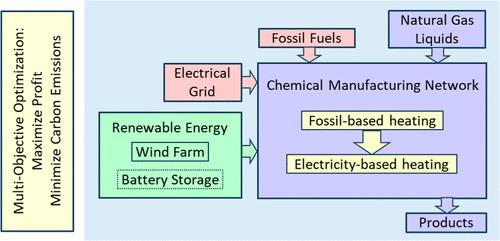当前位置:
X-MOL 学术
›
Ind. Eng. Chem. Res.
›
论文详情
Our official English website, www.x-mol.net, welcomes your feedback! (Note: you will need to create a separate account there.)
Thermal Electrification of Chemical Processes Using Renewable Energy: Economic and Decarbonization Impacts
Industrial & Engineering Chemistry Research ( IF 3.8 ) Pub Date : 2024-06-25 , DOI: 10.1021/acs.iecr.4c00737 Ioannis Giannikopoulos 1 , Alkiviadis Skouteris 1 , David T. Allen 1, 2 , Michael Baldea 1, 3 , Mark A. Stadtherr 1
Industrial & Engineering Chemistry Research ( IF 3.8 ) Pub Date : 2024-06-25 , DOI: 10.1021/acs.iecr.4c00737 Ioannis Giannikopoulos 1 , Alkiviadis Skouteris 1 , David T. Allen 1, 2 , Michael Baldea 1, 3 , Mark A. Stadtherr 1
Affiliation

|
The contribution of renewable energy sources to the power generation portfolio has been increasing in recent years, offering new opportunities for chemical industry electrification and decarbonization. However, renewables often face challenges that may affect their optimal utilization. Wind and solar power generation are highly variable over time, which can lead to a mismatch between electricity output and demand. In this work, we aim to identify optimal ways of more efficiently using wind-generated power through the direct electrification of chemical manufacturing, specifically the replacement of fossil-based thermal heating with electricity-based heating. We implement a multiperiod, multiobjective optimization model formulated as a mixed-integer linear program (MILP). Profit and CO2-equivalent emissions are used as competing objectives in an effort to study the impact of variable renewable energy generation and how it can enable the shift toward lower carbon emissions in chemical manufacturing. The model’s capabilities are illustrated using a process network structure involving chemical processes that can use natural gas liquids as raw materials and a wind farm for power generation. The results demonstrate that the use of renewable electricity is impactful and, through thermal electrification, provides significant CO2 emissions reduction. The coproduction and sale of chemicals and renewable electricity are shown to further accelerate the adoption of process electrification, emphasizing the importance of sector coupling (manufacturing–power grid) in promoting decarbonization. As emission limits become stricter, a transition point is identified beyond which thermal electrification alone is insufficient to meet the emissions target, and reductions in production and/or changing the product mix is necessary to maintain an optimal profit.
中文翻译:

使用可再生能源的化学过程热电化:经济和脱碳影响
近年来,可再生能源对发电组合的贡献不断增加,为化工行业电气化和脱碳提供了新的机遇。然而,可再生能源经常面临可能影响其最佳利用的挑战。风能和太阳能发电随着时间的推移变化很大,这可能导致电力输出和需求之间的不匹配。在这项工作中,我们的目标是通过化学制造的直接电气化来确定更有效地使用风力发电的最佳方法,特别是用电力供暖替代化石热供暖。我们实现了一个多周期、多目标优化模型,该模型被表述为混合整数线性程序(MILP)。利润和二氧化碳 2 -当量排放量被用作竞争目标,以研究可变可再生能源发电的影响以及它如何能够实现化学制造中向低碳排放的转变。该模型的功能通过过程网络结构来说明,该结构涉及可以使用天然气液体作为原材料的化学过程和风力发电场。结果表明,可再生电力的使用具有影响力,并且通过热力电气化可以显着减少二氧化碳 2 排放。化学品和可再生电力的联合生产和销售被证明可以进一步加速过程电气化的采用,强调部门耦合(制造业-电网)在促进脱碳方面的重要性。 随着排放限制变得更加严格,确定了一个过渡点,超过该过渡点仅靠热电化不足以满足排放目标,并且需要减少产量和/或改变产品结构以保持最佳利润。
更新日期:2024-06-25
中文翻译:

使用可再生能源的化学过程热电化:经济和脱碳影响
近年来,可再生能源对发电组合的贡献不断增加,为化工行业电气化和脱碳提供了新的机遇。然而,可再生能源经常面临可能影响其最佳利用的挑战。风能和太阳能发电随着时间的推移变化很大,这可能导致电力输出和需求之间的不匹配。在这项工作中,我们的目标是通过化学制造的直接电气化来确定更有效地使用风力发电的最佳方法,特别是用电力供暖替代化石热供暖。我们实现了一个多周期、多目标优化模型,该模型被表述为混合整数线性程序(MILP)。利润和二氧化碳 2 -当量排放量被用作竞争目标,以研究可变可再生能源发电的影响以及它如何能够实现化学制造中向低碳排放的转变。该模型的功能通过过程网络结构来说明,该结构涉及可以使用天然气液体作为原材料的化学过程和风力发电场。结果表明,可再生电力的使用具有影响力,并且通过热力电气化可以显着减少二氧化碳 2 排放。化学品和可再生电力的联合生产和销售被证明可以进一步加速过程电气化的采用,强调部门耦合(制造业-电网)在促进脱碳方面的重要性。 随着排放限制变得更加严格,确定了一个过渡点,超过该过渡点仅靠热电化不足以满足排放目标,并且需要减少产量和/或改变产品结构以保持最佳利润。
















































 京公网安备 11010802027423号
京公网安备 11010802027423号